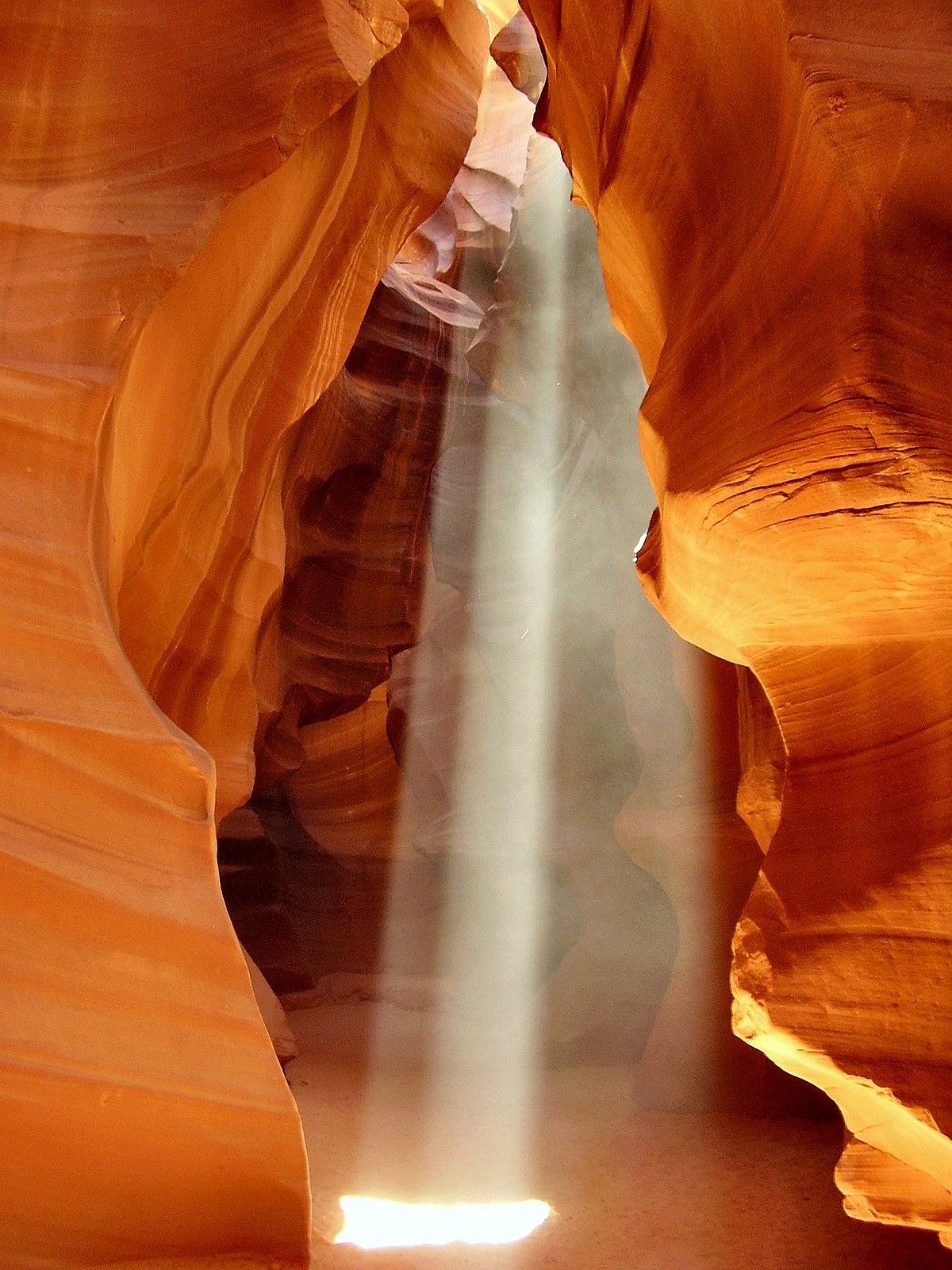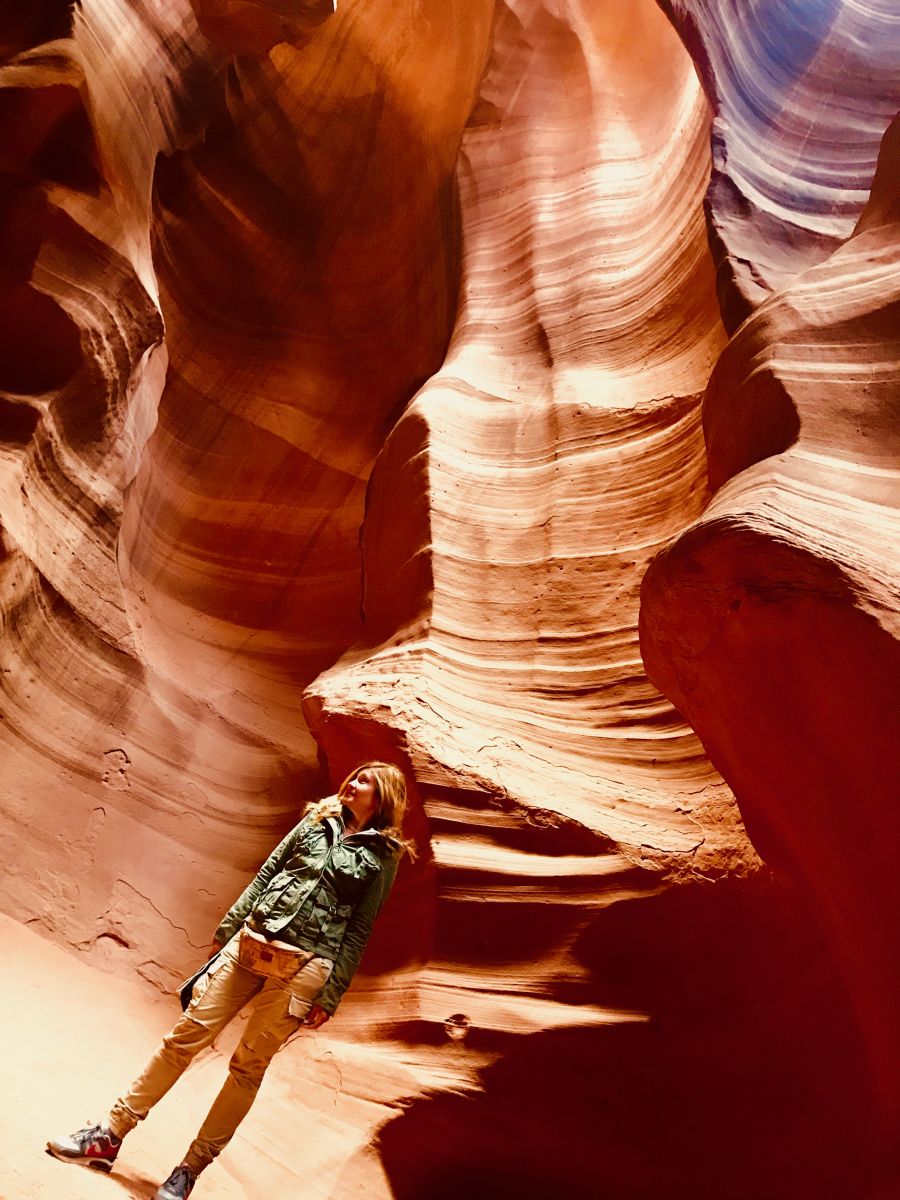Antelope Canyon in Page, Arizona, is renowned for its stunning slot canyons.
BOok A FLIGHT





Antelope Canyon, located near Page, Arizona, is one of the most photographed slot canyons in the American Southwest. It is situated on Navajo land and is renowned for its narrow, winding paths and stunning light beams that shine down into the openings of the canyon, creating a surreal and beautiful landscape. Here are some of the key features of Antelope Canyon:
Slot Canyon Formation: Antelope Canyon is a prime example of a slot canyon, which is formed by the erosion of Navajo Sandstone primarily due to flash flooding and other sub-aerial processes. Its corridors are tall and narrow, creating a unique and picturesque natural phenomenon.
Light Beams: One of the most striking features of Antelope Canyon are the light beams that appear at certain times of the day, especially during midday from March to October. These beams create a magical atmosphere as they illuminate the dusty air and the canyon's sinuous walls.
Geological Features: The canyon walls are known for their wave-like structure and the warm glow of red, orange, pink, and purple hues, depending on the time of day and season. The erosion patterns have created a mesmerizing landscape of rock formations.
Upper and Lower Sections: Antelope Canyon is divided into two separate sections, referred to as Upper Antelope Canyon (or The Crack) and Lower Antelope Canyon (or The Corkscrew). Each section offers a distinct experience. The Upper Canyon is known for its light beams and easier walk, while the Lower Canyon is more about the adventure of navigating through narrower spaces.
Cultural Significance: For the Navajo people, Antelope Canyon holds spiritual and cultural significance. It is considered a sacred site, and many Navajo guides share stories and insights about the canyon's history and its importance to their culture.
Guided Tours Only: Access to Antelope Canyon is restricted to guided tours led by authorized Navajo guides. This regulation helps protect the canyon from damage, ensures visitor safety, and respects the cultural significance of the site.
Photography: Antelope Canyon is a haven for photographers, from professionals to amateurs, due to its extraordinary light conditions and stunning geological formations. Special photography tours are available, offering more time and guidance for capturing the perfect shot.
Wildlife: The area around Antelope Canyon is home to various desert wildlife, including the antelope for which the canyon is named, although sightings of antelope within the canyon are now rare.
Accessibility: Upper Antelope Canyon is more accessible, with no climbing required, making it suitable for visitors of all ages and physical conditions. Lower Antelope Canyon requires some climbing and navigating through tighter spaces.
Seasonal Variations: The appearance of Antelope Canyon can change dramatically with the seasons, with summer offering the most dramatic light beams, and the winter months providing a quieter, more introspective experience.
Visiting Antelope Canyon offers a unique opportunity to witness the power of natural forces and the beauty they can create, making it a must-see destination for nature lovers, photographers, and anyone interested in the great outdoors.
Feels like 45°F. clear sky
broken clouds
overcast clouds
overcast clouds
overcast clouds
light rain
scattered clouds
overcast clouds
Antelope Canyon is a popular slot canyon located near Page, Arizona, in the American Southwest. It's known for its wave-like structure and the light beams that shine down into the openings of the canyon, creating a surreal and beautiful experience. Antelope Canyon is on Navajo land, and visiting it requires booking a tour with a licensed tour operator. Here's how to get to Antelope Canyon from Page, Arizona:
Page, Arizona, is the nearest city to Antelope Canyon and serves as the base for most visitors. If you're starting from Page:
Driving Directions to Upper Antelope Canyon:
Driving Directions to Lower Antelope Canyon:
Remember, conditions and access policies can change, so it's a good idea to check the latest information with your tour operator or the Navajo Nation Parks & Recreation website before your visit.
Antelope Canyon is located near the city of Page in northern Arizona, United States. It is within the Navajo Nation, a large Native American territory. Antelope Canyon is famous for its narrow, winding corridors and stunning light beams that shine down into the slots, creating breathtaking views. It is divided into two separate sections, commonly referred to as Upper Antelope Canyon (or The Crack) and Lower Antelope Canyon (or The Corkscrew). The canyon is a popular destination for photographers and tourists alike, known for its incredible natural beauty and unique geological formations.
The best time to visit Antelope Canyon in Page, Arizona, is typically during the late spring to early fall months, with peak visiting times being from May through September. This period offers the most favorable weather conditions and the chance to see the famous light beams in Upper Antelope Canyon, which are most prominent around midday from late March through early October. However, these months are also the busiest, so booking tours well in advance is advisable.
If you prefer a less crowded experience and don't mind missing the light beams, visiting in the shoulder seasons (March-April and October-November) can also be rewarding. The weather is cooler, and the softer light offers a different but equally beautiful perspective on the canyon's colors and textures.
Keep in mind that Antelope Canyon is a protected site and can only be visited with a guided tour, so planning ahead is crucial regardless of when you decide to go.
Exploring Antelope Canyon in Page, Arizona, typically requires less than a day. The canyon consists of two separate sections, Upper Antelope Canyon and Lower Antelope Canyon. Each section can be toured in about 1 to 2 hours, not including the time it takes to get to the site and prepare for the tour.
Most visitors choose to explore either the Upper or Lower canyon in a single visit, though it's possible to visit both in one day if you start early and plan your tours accordingly. Keep in mind that you can only visit Antelope Canyon as part of a guided tour due to the Navajo Nation's regulations, which manage the site.
If you're also interested in exploring the surrounding area, including Lake Powell, Horseshoe Bend, and other nearby attractions, you might want to allocate 2 to 3 days in total for your visit to Page, Arizona. This will give you enough time to enjoy the natural beauty and outdoor activities the region has to offer without feeling rushed.
Antelope Canyon, located near Page, Arizona, is one of the most picturesque slot canyons in the world and offers a unique and mesmerizing experience for visitors. Here are some interesting facts about this natural wonder:
Formation: Antelope Canyon was formed by the erosion of Navajo Sandstone, primarily due to flash flooding and other sub-aerial processes. Over time, the passageways have been smoothed and shaped by water and wind, creating the flowing shapes in the rock.
Navajo Name: The canyon is known as "Tsé bighánílíní" by the Navajo, which means "the place where water runs through rocks." This name reflects the canyon's creation through erosion by water.
Two Sections: Antelope Canyon is divided into two separate sections, referred to as "Upper Antelope Canyon" or "The Crack" and "Lower Antelope Canyon" or "The Corkscrew." Each section offers unique views and experiences. The Upper Canyon is known for its light beams that shine down into the openings of the canyon, while the Lower Canyon is famous for its spiral rock arches.
Photography: Antelope Canyon is a highly sought-after location for photographers, thanks to its incredible light beams and coloration. The play of light through the canyon walls creates breathtaking scenes, making it a popular spot for both professional and amateur photographers.
Access and Tours: Access to Antelope Canyon is restricted and can only be visited with a guided tour led by a Navajo guide. This is because the canyon lies within the Navajo Nation Reservation. The requirement for guided tours helps protect the site and ensures visitor safety.
Flash Floods: The canyon is prone to flash floods, which can be extremely dangerous. The same forces that created the beautiful corridors can quickly become hazardous. Tour operators monitor weather conditions closely to ensure visitor safety.
Cultural Significance: For the Navajo people, Antelope Canyon holds spiritual significance. It is considered a sacred site, and many Navajo guides share stories and insights about their culture and the canyon's history during tours.
Wildlife: The name "Antelope Canyon" was given by early settlers due to the presence of pronghorn antelope in the area. While it's rare to see antelope in the canyon today, the name persists.
Geological Interest: Beyond its visual beauty, Antelope Canyon is of interest to geologists for its classic example of slot canyon formation, providing insights into the region's geological history and the processes that shape the landscape.
Tourism Impact: The popularity of Antelope Canyon has grown significantly, making it one of the most visited slot canyons in the American Southwest. This has brought both economic benefits and challenges in managing the impact of tourism on the natural environment.
Antelope Canyon continues to captivate visitors from around the world with its awe-inspiring beauty and serves as a reminder of nature's power to create and transform landscapes.